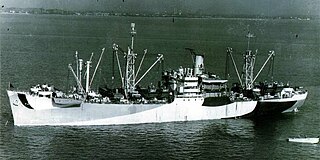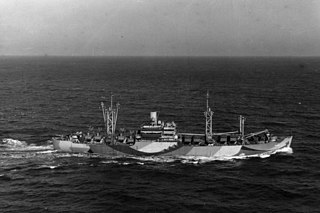
USS Southampton (AKA-66) was a Tolland-class attack cargo ship in service with the United States Navy from 1944 to 1946. She was sold into commercial service and scrapped in 1971.

USS Suffolk (AKA-69) was a Tolland-class attack cargo ship in service with the United States Navy from 1944 to 1946. She was sold into commercial service and was scrapped in 1971.

USS Trousdale (AKA-79) was a Tolland-class attack cargo ship in service with the United States Navy from 1944 to 1946. She was sold into commercial service and was scrapped in 1968.

USS Tyrrell (AKA-80) was a Tolland-class attack cargo ship in service with the United States Navy from 1944 to 1946. She was sold into commercial service and was scrapped in 1967.

USS Venango (AKA-82) was a Tolland-class attack cargo ship in service with the United States Navy from 1945 to 1946. She was sold into commercial service and was scrapped in 1971.

USS Wheatland (AKA-85) was a Tolland-class attack cargo ship in service with the United States Navy from 1945 to 1946. She was sold into commercial service and was scrapped in 1973.

USS Thuban (AKA-19/LKA-19) was an Andromeda-class attack cargo ship in service with the United States Navy from 1943 to 1967. The ship was scrapped in 1984.
USS Valeria (AKA-48) was an Artemis-class attack cargo ship named after the minor planet 611 Valeria, discovered in 1906 by Joel Hastings Metcalf, an amateur astronomer who made the initial identification of 41 minor planets. The meaning of the name is unknown. Valeria served as a commissioned ship for 8 months.

USS Sylvania (AKA-44) was an Artemis-class attack cargo ship in service with the United States Navy from 1945 to 1046. She was scrapped in 1964.

USS Ostara (AKA-33) was an Artemis-class attack cargo ship named after the asteroid 343 Ostara, which in turn was named after the Teutonic goddess of spring, described by Jacob Grimm in his Deutsche Mythologie as equivalent to the Anglo-Saxon Eostre. USS Ostara served as a commissioned ship for 13 months.

USS Birgit (AKA-24) was an Artemis-class attack cargo ship named after the minor planet 960 Birgit, which in turn was named after a daughter of Swedish astronomer Bror Ansgar Asplind. USS Birgit served as a commissioned ship for 16 months.

USS Athene (AKA-22) was an Artemis-class attack cargo ship in service with the United States Navy from 1944 to 1946.

USS Artemis (AKA-21) was an Artemis-class attack cargo ship in service with the United States Navy from 1944 to 1947. She was scrapped in 1966.

USS Arenac (APA-128) was a Haskell-class attack transport in service with the United States Navy from 1945 to 1946. She was scrapped in 1974.

USS Braxton (APA-138) was a Haskell-class attack transport in service with the United States Navy from 1944 to 1946. She was scrapped in 1973.

USS LST-31 was a United States Navy LST-1-class tank landing ship used exclusively in the Asiatic-Pacific Theater during World War II. Like many of her class, she was not originally named and is properly referred to by her hull designation. Later she was named for Addison County, Vermont. She was the only US Naval vessel to bear the name.

USS Auriga (AK-98) was an Auriga-class cargo ship, the only ship in her class, commissioned by the U.S. Navy for service in World War II, named after the constellation Auriga. She was responsible for delivering troops, goods and equipment to locations in the war zone.
USS Zaurak (AK-117) was a Crater-class cargo ship commissioned by the U.S. Navy for service in World War II. She was responsible for delivering troops, goods and equipment to locations in the war zone.

USS Buckingham (APA-141) was a Haskell-class attack transport in service with the United States Navy from 1945 to 1946. She was scrapped in 1974.

USS Bergen (APA-150) was a Haskell-class attack transport in service with the United States Navy from 1944 to 1946. She was scrapped in 1973.


















